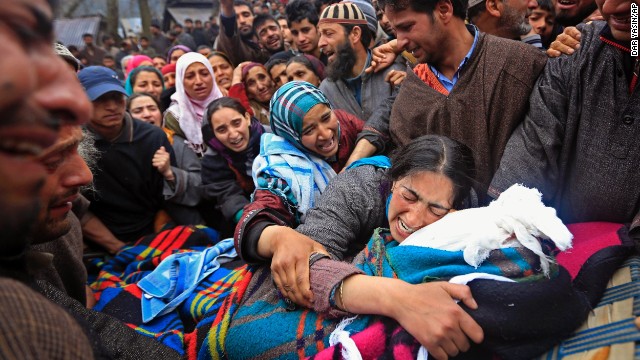 Sumaira Wani, wife of Zia-Ul-Haq, mourns by the body of her husband during his funeral in Hirpora, some 65 kilometers (40 miles) north of Srinagar, India, on Friday, April 25. Zia, an Indian poll official, was killed soon after voting in the ongoing general elections, when suspected rebels fatally shot him and wounded four others in an attack on a bus in the Indian-controlled portion of Kashmir.
Sumaira Wani, wife of Zia-Ul-Haq, mourns by the body of her husband during his funeral in Hirpora, some 65 kilometers (40 miles) north of Srinagar, India, on Friday, April 25. Zia, an Indian poll official, was killed soon after voting in the ongoing general elections, when suspected rebels fatally shot him and wounded four others in an attack on a bus in the Indian-controlled portion of Kashmir. 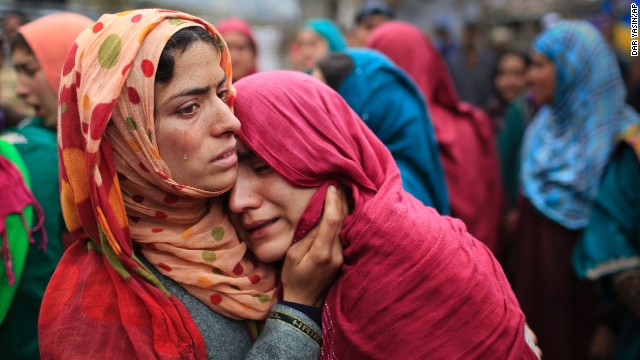 Unidentified relatives cry during the funeral procession of Zia-Ul-Haq in Hirpora, nearly 65 kilometers (40 miles) north of Srinagar, India, on April 25. India's general election is being held in stages over five weeks. Voters will elect 543 members to the lower house of parliament, which will then select the country's next prime minister. Prime Minister Manmohan Singh is stepping aside after a decade in charge.
Unidentified relatives cry during the funeral procession of Zia-Ul-Haq in Hirpora, nearly 65 kilometers (40 miles) north of Srinagar, India, on April 25. India's general election is being held in stages over five weeks. Voters will elect 543 members to the lower house of parliament, which will then select the country's next prime minister. Prime Minister Manmohan Singh is stepping aside after a decade in charge.  An Indian Punjab State Police officer stands in front of a picture of BJP leader Narendra Modi and Punjab Chief Minister Parkash Singh Badal during an election rally by the two men in Bathinda, Punjab, India, on April 25.
An Indian Punjab State Police officer stands in front of a picture of BJP leader Narendra Modi and Punjab Chief Minister Parkash Singh Badal during an election rally by the two men in Bathinda, Punjab, India, on April 25.  Indian women cast their vote during the sixth phase of polling in the Indian parliamentary elections at a village near Sawai Madhopur, Rajasthan state, India, on Thursday, April 24.
Indian women cast their vote during the sixth phase of polling in the Indian parliamentary elections at a village near Sawai Madhopur, Rajasthan state, India, on Thursday, April 24.  An Indian woman gives her thumb impression before casting her vote in a village near Sawai Madhopur, in the Indian state of Rajasthan, on April 24.
An Indian woman gives her thumb impression before casting her vote in a village near Sawai Madhopur, in the Indian state of Rajasthan, on April 24.  A polling official carries electronic voting machines at a distribution center in Gauhati, India, on Wednesday, April 23.
A polling official carries electronic voting machines at a distribution center in Gauhati, India, on Wednesday, April 23.  A woman casts her vote on the outskirts of Jaipur, India, on Thursday, April 17. Indians cast ballots Thursday on the biggest day of voting in the country's weeks-long general election, streaming into polling stations even in areas where rebels threatened violence.
A woman casts her vote on the outskirts of Jaipur, India, on Thursday, April 17. Indians cast ballots Thursday on the biggest day of voting in the country's weeks-long general election, streaming into polling stations even in areas where rebels threatened violence.  An elderly man casts his vote inside a polling station in Amroha, India, on April 17.
An elderly man casts his vote inside a polling station in Amroha, India, on April 17.  A supporter of the Peoples Democratic Party shouts slogans during an election campaign rally on the outskirts of Srinagar on April 17. Several separatist organizations have jointly appealed to the people of Jammu and Kashmir to boycott the Indian parliamentary elections.
A supporter of the Peoples Democratic Party shouts slogans during an election campaign rally on the outskirts of Srinagar on April 17. Several separatist organizations have jointly appealed to the people of Jammu and Kashmir to boycott the Indian parliamentary elections.  A helicopter carrying Nagma, a Bollywood actress and Congress party candidate from Meerut, takes off after an election rally on April 17.
A helicopter carrying Nagma, a Bollywood actress and Congress party candidate from Meerut, takes off after an election rally on April 17. 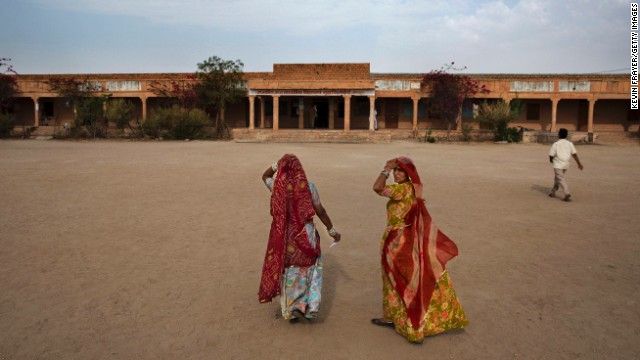 Women arrive to vote at a polling station on April 17, in the desert state of Rajasthan, India.
Women arrive to vote at a polling station on April 17, in the desert state of Rajasthan, India.  People stand in line to cast their votes in Jaipur on April 17.
People stand in line to cast their votes in Jaipur on April 17.  A voter casts her ballot at a polling booth in Doda, India, on April 17. There are 814 million eligible voters in India, making this the largest election in world history.
A voter casts her ballot at a polling booth in Doda, India, on April 17. There are 814 million eligible voters in India, making this the largest election in world history.  An Indian election official marks the finger of a voter with ink before she casts her ballot in Sambhar, India, on April 17.
An Indian election official marks the finger of a voter with ink before she casts her ballot in Sambhar, India, on April 17. 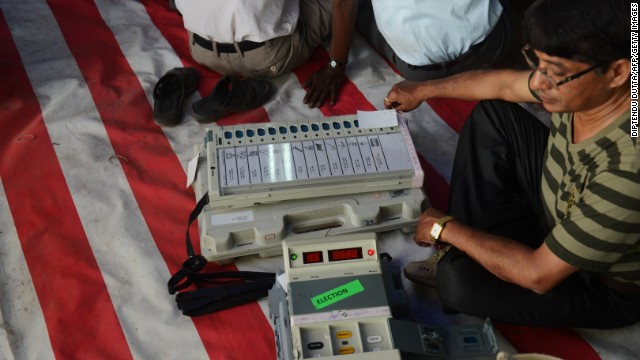 An election official checks an electronic voting machine before taking it to polling stations at a distribution center in Siliguri, India, on Wednesday, April 16.
An election official checks an electronic voting machine before taking it to polling stations at a distribution center in Siliguri, India, on Wednesday, April 16.  An election official carries an electronic voting machine across a makeshift bridge after picking it up from a distribution center in Doda on April 16.
An election official carries an electronic voting machine across a makeshift bridge after picking it up from a distribution center in Doda on April 16. 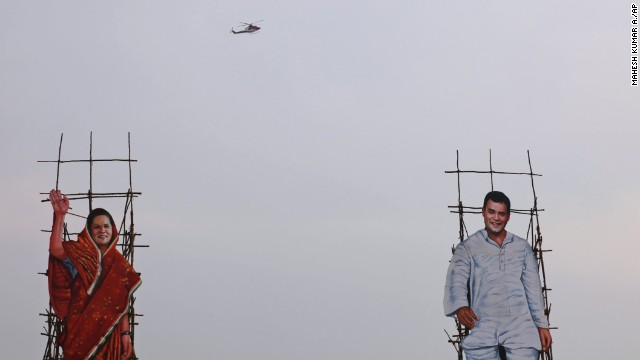 Portraits of Congress Party President Sonia Gandhi, left, and Vice President Rahul Gandhi are seen at an election rally in Karimnagar, India, on April 16.
Portraits of Congress Party President Sonia Gandhi, left, and Vice President Rahul Gandhi are seen at an election rally in Karimnagar, India, on April 16.  Security personnel load their luggage on a bus as they leave for various polling centers in Udhampur, India, on Tuesday, April 15.
Security personnel load their luggage on a bus as they leave for various polling centers in Udhampur, India, on Tuesday, April 15.  A young girl watches an election campaign rally from her house in Rawalpora, India, on April 15.
A young girl watches an election campaign rally from her house in Rawalpora, India, on April 15.  Supporters of India's main opposition Bharatiya Janata Party dance during a campaign rally in Udhampur on April 15.
Supporters of India's main opposition Bharatiya Janata Party dance during a campaign rally in Udhampur on April 15.  A worker arranges masks of Bharatiya Janata Party candidate Narendra Modi at a printing press in Ahmedabad, India, on Saturday, April 12.
A worker arranges masks of Bharatiya Janata Party candidate Narendra Modi at a printing press in Ahmedabad, India, on Saturday, April 12.  A woman carries her child and waits for her identity to be checked before voting in Diphu, India, on April 12.
A woman carries her child and waits for her identity to be checked before voting in Diphu, India, on April 12. 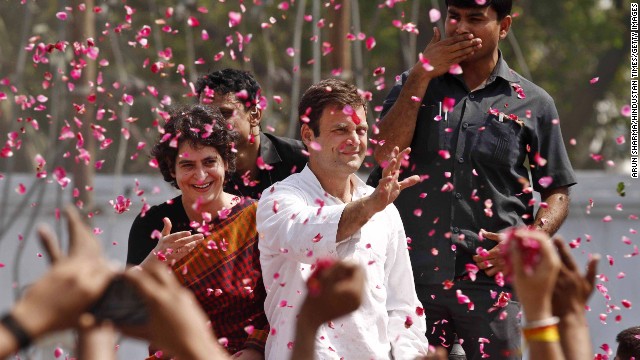 Rahul Gandhi, one of the leading candidates for prime minister, waves to supporters in Amethi, India, as he arrives to file his nomination on April 12.
Rahul Gandhi, one of the leading candidates for prime minister, waves to supporters in Amethi, India, as he arrives to file his nomination on April 12.  Congress Party supporters hold flags as they walk home from a Gandhi rally April 12 in the northern state of Uttar Pradesh.
Congress Party supporters hold flags as they walk home from a Gandhi rally April 12 in the northern state of Uttar Pradesh.  Gaurav Shrinivas Sharma, a climber nicknamed Indian Spiderman, campaigns in Mumbai, India, on Friday, April 11. Sharma is an independent candidate from the South Mumbai constituency.
Gaurav Shrinivas Sharma, a climber nicknamed Indian Spiderman, campaigns in Mumbai, India, on Friday, April 11. Sharma is an independent candidate from the South Mumbai constituency.  People in Doda wave as a helicopter carrying Gandhi leaves after a campaign rally on April 11.
People in Doda wave as a helicopter carrying Gandhi leaves after a campaign rally on April 11.  Indian Muslims wait outside a polling booth to cast their votes on Thursday, April 10.
Indian Muslims wait outside a polling booth to cast their votes on Thursday, April 10.  A paramilitary soldier stands guard inside a room containing ballot boxes on April 10.
A paramilitary soldier stands guard inside a room containing ballot boxes on April 10.  A woman casts her vote in Muzaffarnagar, India, on April 10.
A woman casts her vote in Muzaffarnagar, India, on April 10.  Voters wait for their identities to be verified before casting their ballots April 10 in Haryana, India.
Voters wait for their identities to be verified before casting their ballots April 10 in Haryana, India.  A woman points out her photo before casting her vote in New Delhi on April 10.
A woman points out her photo before casting her vote in New Delhi on April 10.  Jyoti Amge, a first-time voter and the world's shortest woman according to Guinness World Records, gets her finger marked with ink after voting in Nagpur, India, on April 10.
Jyoti Amge, a first-time voter and the world's shortest woman according to Guinness World Records, gets her finger marked with ink after voting in Nagpur, India, on April 10.  A woman is given directions by a polling station officer in Haryana on April 10.
A woman is given directions by a polling station officer in Haryana on April 10.  Voters leave a polling station in Muzaffarnagar on April 10.
Voters leave a polling station in Muzaffarnagar on April 10.  A polling officer checks the number of an electronic voting machine after it was deposited in Senapati, India, on Wednesday, April 9.
A polling officer checks the number of an electronic voting machine after it was deposited in Senapati, India, on Wednesday, April 9.  A polling official marks a voter's finger with ink in Senapati on April 9.
A polling official marks a voter's finger with ink in Senapati on April 9.  An elderly man casts his vote in Manipur, India, on April 9.
An elderly man casts his vote in Manipur, India, on April 9. 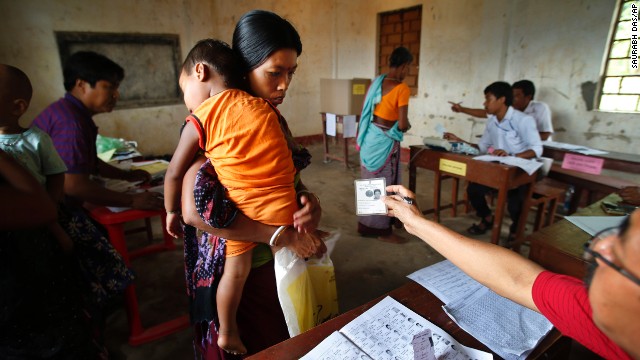 An official checks a voter's identity card in Agartala, India, on Monday, April 7.
An official checks a voter's identity card in Agartala, India, on Monday, April 7.  People wait in lines to cast their votes in Agartala on April 7.
People wait in lines to cast their votes in Agartala on April 7.  An election official checks the identity of a voter on April 7.
An election official checks the identity of a voter on April 7.  A woman with a baby casts her vote inside a polling center at Misamora Sapori, an island in the Brahmaputra River, on April 7.
A woman with a baby casts her vote inside a polling center at Misamora Sapori, an island in the Brahmaputra River, on April 7.  Rahul Gandhi addresses supporters during an election rally in Bangalore, India, on April 7. Gandhi's great-grandfather, grandmother and father have all served as prime minister.
Rahul Gandhi addresses supporters during an election rally in Bangalore, India, on April 7. Gandhi's great-grandfather, grandmother and father have all served as prime minister.  Running against Gandhi is Narendra Modi, chief minister of the western state of Gujarat with a reputation as a tough, "can-do" administrator.
Running against Gandhi is Narendra Modi, chief minister of the western state of Gujarat with a reputation as a tough, "can-do" administrator. 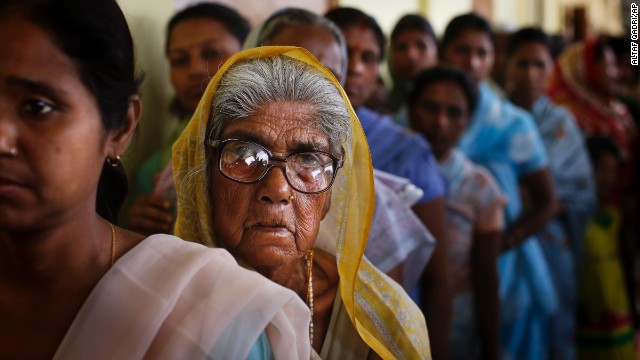 Indians in Dibrugarh stand in a line to cast their vote on April 7.
Indians in Dibrugarh stand in a line to cast their vote on April 7. 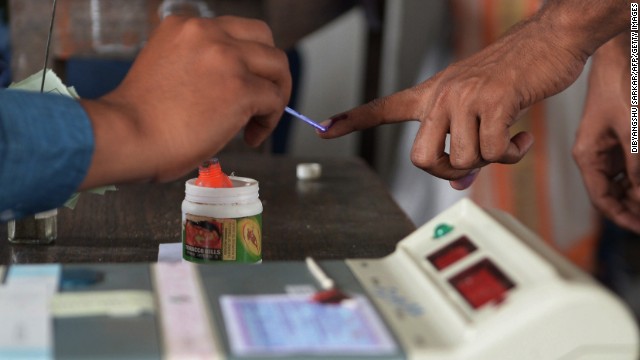 An election officer uses ink to mark a voter's finger at a polling station in Dibrugarh on April 7.
An election officer uses ink to mark a voter's finger at a polling station in Dibrugarh on April 7.  A polling officer in Agartala looks for a voter's name in the registered voter list April 7.
A polling officer in Agartala looks for a voter's name in the registered voter list April 7.  A polling official in Dibrugarh tests an electronic voting machine prior to the start of voting April 7.
A polling official in Dibrugarh tests an electronic voting machine prior to the start of voting April 7.  People wait in line to cast their votes during the first phase of voting in Dibrugarh.
People wait in line to cast their votes during the first phase of voting in Dibrugarh.  Women voters wait outside a polling station in Dibrugarh on April 7.
Women voters wait outside a polling station in Dibrugarh on April 7.
- A commercial shows India voter catching a politician recycling old, unfulfilled promises
- Ravi Agrawal: The power of mobile technology is helping shape India's elections
- He says other key trends include the new prominence of rural areas and of young voters
- Agrawal: It's a mistake to try to predict the outcome based on these trends
Editor's note: Ravi Agrawal is CNN's New Delhi Bureau chief and was formerly senior producer of the network's "Fareed Zakaria GPS." Follow him on Twitter: @RaviAgrawalCNN
New Delhi (CNN) -- Here's the best way to understand the new India in 30 seconds. Watch this commercial—or better yet, if you don't understand Hindi, read on.
A smarmy-looking politician addresses a rural gathering, promising to give the people access to water. His speech is interrupted by a boyish young man, a villager, who pulls out his smartphone and plays a YouTube video for all to see: it's the same politician, making the same promises at the last election, years ago.
"I might be from the village," cries out the young man, "but don't think you can fool me!" The commercial—marketing an Indian mobile service provider—cuts to its familiar Hindi jingle, loosely translated as "no making fools of us anymore, no making fools of us."
The story struck me because it weaves together some important trends and forces in India as the nation undertakes the biggest elections in world history.
The first trend is the immense proliferation of Internet-enabled smartphones. In most Western countries, people have discovered the Internet and grown with it in stages: from painfully slow dial-up connections, to broadband, to Wi-Fi, to 4G mobile Internet.
India's story has been very different. Until recently only a small elite—about a tenth of the population—could access the Internet, mostly through PCs. Even today, there are only 57 million broadband subscribers in the country, according to the Telecom Regulatory Authority of India, or TRAI.
 Inflation key factor for India elections
Inflation key factor for India elections  'Indian Spider-Man' campaigns for office
'Indian Spider-Man' campaigns for office  Millions of voters head to polls in India
Millions of voters head to polls in India By comparison, there are about 900 million mobile subscribers—a recent boom. Many of these mobile users are buying cheap smartphones and data packages to access the Internet. The offshoot is the opposite of what happens in the West: Hundreds of millions of Indians have never used a PC—and likely never will—but they can now begin to access the Internet on their phones. The Internet is aspirational in India; it's the new motorbike or washing machine.
The second trend is the rise of rural India. Again, according to TRAI, 40% of mobile subscribers are now in villages and small towns. Even with the recent boom, rural subscriptions are still growing at more than twice the rate of urban ones.
These rural subscribers, as the commercial shows, often don't speak English. But there's no longer a great shame in being unable to speak the language of their colonial masters; instead, there's a new pride and confidence in India's many regional dialects and languages. There's new rural money, and a yearning to be stakeholders in their futures and to fight for more accountable government.
The third trend is India's youth bulge. More than 100 million voters in India's elections are first-timers who turned 18 in the last five years. Half of all Indians are under age 30; the average age in India is 28.
Many of these young, brash Indians have cast off the fatalism of their forefathers. Growing up in an India of fast growth and development, they have more confidence in their culture, identity and language. Put that together with trends No. 1 and No. 2, and the result is amplified. For the first time in India's history, a majority of Indians are connected and engaged. They know about the skeletons in every politician's closet—and that information is power.
Some suggest that these trends mean India's elections will be fought and decided on social media.
Politicians have taken their cue, rushing to every platform available: Twitter, Facebook and Google Hangouts. The numbers seem staggering at first. Facebook says Narendra Modi, the front-runner to be India's next prime minister, is the second most "liked" politician in the world (13 million likes), after U.S. President Barack Obama (40 million likes).
According to Twitter, there has been a 600% increase in political Tweets from India in the last year. Since January the two biggest parties, the BJP and the Congress, have grown their Twitter followings by 55% and 351% respectively.
India's Internet and Mobile Association says a strong social media campaign could swing up to 4% of votes.
Commentators have cited that data to brand India's elections the country's first-ever "social media election."
For now, I'm skeptical. Some of the outreach attempts have been amateur at best: As Vox.com pointed out, the BJP's Twitter handle last week auto-tweeted anyone who mentioned the party on Twitter, including me and hundreds of others. In any case, the number of actual social media users represents a tiny percentage of the Indian electorate. Facebook says it has 100 million users in India: it sounds like a lot but it accounts for less than a tenth of Indians.
One reason for this -- apart from limits to Internet access -- could be that Twitter and Facebook remain English language services, relatable to a small subset of Indians.
Unlike China, which has a Chinese-language microblogging service called Sina Weibo, with hundreds of millions of users, India for now has no such indigenous, umbrella platform.
Why? India is no monolith. There are dozens of languages, and an equal number of different Indias. Despite India's growth and increased connectivity, which suggests a more unified nation, the country may actually be becoming more regional-focused, with more pride in local languages, trends and politicians. This is also why I think it's far too early to call India's elections for any one politician or party. The three trends of mobile reach, the rural rise and the youth bulge are each combustible forces bubbling in a cauldron of uncertainty.
Indians may want accountability and change, but it's too soon to tell which way that will manifest itself. It remains unclear whether Indians will vote for their regional interests, or cast their ballot thinking about a macro national picture.
Watch India's elections very closely. They're immensely consequential—for India, and the world. But placing too much importance on social media chatter could be misleading. Calling these elections too early could be embarrassing, too. It is, as the ad-jingle goes, a fool's errand.
Follow @CNNOpinion on Twitter.
Join us on Facebook/CNNOpinion.
No comments:
Post a Comment